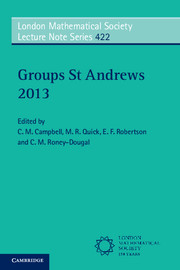Book contents
- Frontmatter
- Contents
- INTRODUCTION
- Approximate subgroups and super-strong approximation
- Width questions for finite simple groups
- Profinite properties of discrete groups
- GL(n, Z), Out(Fn) and everything in between: automorphism groups of RAAGs
- Permutation groups and transformation semigroups: results and problems
- New progress on factorized groups and subgroup permutability
- A survey on the normalizer problem for integral group rings
- A survey on Clifford-Fischer theory
- A generalisation on the solvability of finite groups with three class sizes for normal subgroups
- Automorphism groups of non-orientable Riemann surfaces
- What are the C2-groups?
- Resurrecting Wells’ exact sequence and Buckley's group action
- Recent work on Beauville surfaces, structures and groups
- Something for nothing: some consequences of the solution of the Tarski problems
- The groups of projectivities in finite planes
- On the relation gap and relation lifting problem
- Some results on products of finite subsets in groups
- Formal languages and group theory
- On the Castelnuovo-Mumford regularity of the cohomology of fusion systems and of the Hochschild cohomology of block algebras
- Recent advances on torsion subgroups of integral group rings
- On finite groups with small prime spectrum
- Solvability criteria for finite loops and groups
- The rational subset membership problem for groups: a survey
- A survey of Milnor laws
- Capable p-groups
- On the normal structure of a finite group with restrictions on the maximal subgroups
- Certain monomial characters and their normal constituents
- Recognition of finite quasi-simple groups by the degrees of their irreducible representations
- Generalized Baumslag-Solitar groups: a survey of recent progress
- Zeta functions of groups and rings – recent developments
The rational subset membership problem for groups: a survey
Published online by Cambridge University Press: 05 September 2015
- Frontmatter
- Contents
- INTRODUCTION
- Approximate subgroups and super-strong approximation
- Width questions for finite simple groups
- Profinite properties of discrete groups
- GL(n, Z), Out(Fn) and everything in between: automorphism groups of RAAGs
- Permutation groups and transformation semigroups: results and problems
- New progress on factorized groups and subgroup permutability
- A survey on the normalizer problem for integral group rings
- A survey on Clifford-Fischer theory
- A generalisation on the solvability of finite groups with three class sizes for normal subgroups
- Automorphism groups of non-orientable Riemann surfaces
- What are the C2-groups?
- Resurrecting Wells’ exact sequence and Buckley's group action
- Recent work on Beauville surfaces, structures and groups
- Something for nothing: some consequences of the solution of the Tarski problems
- The groups of projectivities in finite planes
- On the relation gap and relation lifting problem
- Some results on products of finite subsets in groups
- Formal languages and group theory
- On the Castelnuovo-Mumford regularity of the cohomology of fusion systems and of the Hochschild cohomology of block algebras
- Recent advances on torsion subgroups of integral group rings
- On finite groups with small prime spectrum
- Solvability criteria for finite loops and groups
- The rational subset membership problem for groups: a survey
- A survey of Milnor laws
- Capable p-groups
- On the normal structure of a finite group with restrictions on the maximal subgroups
- Certain monomial characters and their normal constituents
- Recognition of finite quasi-simple groups by the degrees of their irreducible representations
- Generalized Baumslag-Solitar groups: a survey of recent progress
- Zeta functions of groups and rings – recent developments
Summary
Abstract
The class of rational subsets of a group G is the smallest class that contains all finite subsets of G and that is closed with respect to union, product and taking the monoid generated by a set. The rational subset membership problem for a finitely generated group G is the decision problem, where for a given rational subset of G and a group element g it is asked whether g ∈ G. This paper presents a survey on known decidability and undecidability results for the rational subset membership problem for groups. The membership problems for finitely generated submonoids and finitely generated subgroups will be discussed as well.
Introduction
The study of algorithmic problems in group theory has a long tradition. Dehn [13], in his seminal paper from 1911, introduced the word problem (Does a given word over the generators represent the identity?), the conjugacy problem (Are two given group elements conjugate?) and the isomorphism problem (Are two given finitely presented groups isomorphic?), see [38] for general references in combinatorial group theory. Starting with the work of Novikov and Boone from the 1950's, all three problems were shown to be undecidable for finitely presented groups in general. A generalization of the word problem is the subgroup membership problem (also known as the generalized word problem) for finitely generated groups: Given group elements g, g1, …, gn, does g belong to the subgroup generated by g1, …, gn? Explicitly, this problem was introduced by Mihailova [42] in 1959, although Nielsen [47] had already presented an algorithm for the subgroup membership problem for free groups in his paper from 1921.
Motivated partly by automata theory, the subgroup membership problem was further generalized to the rational subset membership problem. Assume that the group G is finitely generated by the set X (where a ∈ X if and only if a−1 ∈ X). A finite automaton A with transitions labelled by elements of X defines a subset L(A) ⊆ G in the natural way; such subsets are the rational subsets of G, see Sections 2 and 3 for precise definitions. The rational subset membership problem asks whether a given group element belongs to L(A) for a given finite automaton (in fact, this problem makes sense for any finitely generated monoid).
- Type
- Chapter
- Information
- Groups St Andrews 2013 , pp. 368 - 389Publisher: Cambridge University PressPrint publication year: 2015
- 8
- Cited by



